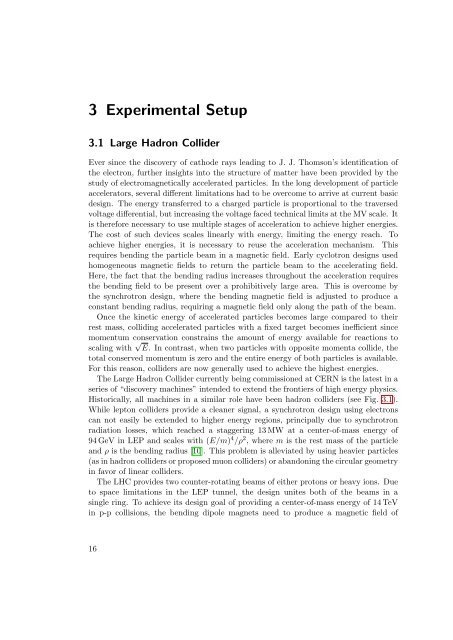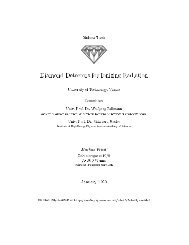You also want an ePaper? Increase the reach of your titles
YUMPU automatically turns print PDFs into web optimized ePapers that Google loves.
3 Experimental Setup3.1 Large Hadron ColliderEver since the discovery of cathode rays leading to J. J. Thomson’s identification ofthe electron, further insights into the structure of matter have been provided by thestudy of electromagnetically accelerated particles. In the long development of particleaccelerators, several different limitations had to be overcome to arrive at current basicdesign. The energy transferred to a charged particle is proportional to the traversedvoltage differential, but increasing the voltage faced technical limits at the MV scale. Itis therefore necessary to use multiple stages of acceleration to achieve higher energies.The cost of such devices scales linearly with energy, limiting the energy reach. Toachieve higher energies, it is necessary to reuse the acceleration mechanism. Thisrequires bending the particle beam in a magnetic field. Early cyclotron designs usedhomogeneous magnetic fields to return the particle beam to the accelerating field.Here, the fact that the bending radius increases throughout the acceleration requiresthe bending field to be present over a prohibitively large area. This is overcome bythe synchrotron design, where the bending magnetic field is adjusted to produce aconstant bending radius, requiring a magnetic field only along the path of the beam.Once the kinetic energy of accelerated particles becomes large compared to theirrest mass, colliding accelerated particles with a fixed target becomes inefficient sincemomentum conservation constrains the amount of energy available for reactions toscaling with √ E. In contrast, when two particles with opposite momenta collide, thetotal conserved momentum is zero and the entire energy of both particles is available.For this reason, colliders are now generally used to achieve the highest energies.The Large Hadron Collider currently being commissioned at CERN is the latest in aseries of “discovery machines” intended to extend the frontiers of high energy physics.Historically, all machines in a similar role have been hadron colliders (see Fig. 3.1).While lepton colliders provide a cleaner signal, a synchrotron design using electronscan not easily be extended to higher energy regions, principally due to synchrotronradiation losses, which reached a staggering 13 MW at a center-of-mass energy of94 GeV in LEP and scales with (E/m) 4 /ρ 2 , where m is the rest mass of the particleand ρ is the bending radius [10]. This problem is alleviated by using heavier particles(as in hadron colliders or proposed muon colliders) or abandoning the circular geometryin favor of linear colliders.The LHC provides two counter-rotating beams of either protons or heavy ions. Dueto space limitations in the LEP tunnel, the design unites both of the beams in asingle ring. To achieve its design goal of providing a center-of-mass energy of 14 TeVin p-p collisions, the bending dipole magnets need to produce a magnetic field of16












